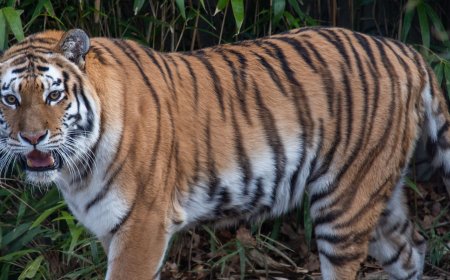How To Hike Cedar Mountain Preserve Dallas
How to Hike Cedar Mountain Preserve Dallas Cedar Mountain Preserve in Dallas, Texas, is a hidden gem nestled within the urban sprawl of North Texas — a sanctuary of native flora, rolling limestone outcrops, and serene trails that offer hikers an immersive escape from city life. Despite its proximity to major highways and residential neighborhoods, this 160-acre natural area remains relatively unkn
How to Hike Cedar Mountain Preserve Dallas
Cedar Mountain Preserve in Dallas, Texas, is a hidden gem nestled within the urban sprawl of North Texas — a sanctuary of native flora, rolling limestone outcrops, and serene trails that offer hikers an immersive escape from city life. Despite its proximity to major highways and residential neighborhoods, this 160-acre natural area remains relatively unknown to many locals, preserving its quiet charm and ecological integrity. For outdoor enthusiasts, nature photographers, and fitness seekers alike, learning how to hike Cedar Mountain Preserve Dallas is more than a recreational activity — it’s a chance to connect with the region’s unique geology, support conservation efforts, and experience the tranquility of undisturbed woodland ecosystems.
The preserve is managed by the Dallas Audubon Society and the City of Dallas Parks and Recreation Department, ensuring that trails remain well-maintained, signage is clear, and wildlife habitats are protected. Unlike larger, more crowded parks, Cedar Mountain Preserve offers a low-traffic, high-reward hiking experience. Whether you’re a beginner seeking a gentle walk or an experienced hiker looking for a brief but rewarding climb, this preserve delivers a balanced blend of accessibility and natural beauty.
This guide provides a comprehensive, step-by-step roadmap to help you plan, prepare for, and enjoy your hike at Cedar Mountain Preserve. From trail selection and gear recommendations to timing your visit and respecting conservation protocols, every element is designed to ensure your experience is safe, sustainable, and deeply rewarding.
Step-by-Step Guide
1. Research and Plan Your Visit
Before setting foot on any trail, begin with thorough research. Cedar Mountain Preserve is not a large park with multiple amenities, so preparation is key. Start by visiting the official Dallas Audubon Society website or the City of Dallas Parks and Recreation portal to confirm current trail conditions, seasonal closures, or special events that may affect access.
Check the weather forecast for Dallas, paying close attention to temperature, humidity, and precipitation. Summer months can see temperatures exceeding 95°F, while winter mornings may dip below freezing. Trails can become slippery after rain, and afternoon thunderstorms are common in spring and early summer. Plan your hike for early morning or late afternoon during warmer months to avoid peak heat.
Also verify parking availability. The preserve has a small gravel lot at the trailhead off Cedar Hill Highway. It can fill up quickly on weekends, especially during fall foliage season. Arriving before 8:00 a.m. ensures a parking spot and quieter trails.
2. Choose the Right Trail
Cedar Mountain Preserve offers three primary trails, each with distinct characteristics:
- The Cedar Ridge Loop – 1.2 miles, easy difficulty. This is the most popular route, ideal for families and casual walkers. It follows a flat, well-marked path along the ridge line with panoramic views of the surrounding oak woodlands.
- The Limestone Climb Trail – 0.8 miles, moderate difficulty. A short but steep ascent up exposed limestone ledges. Offers the best vantage point of the preserve and is recommended for those seeking a brief workout and scenic payoff.
- The Creek Bed Connector – 0.5 miles, easy difficulty. A shaded, meandering path that follows a seasonal creek bed. Best after rainfall when wildflowers bloom and bird activity is high.
For first-time visitors, we recommend combining the Cedar Ridge Loop with the Limestone Climb Trail to form a 2-mile circuit. This loop provides a balanced experience: gentle walking, a moderate climb, and rewarding views without overexertion.
3. Prepare Your Gear
While Cedar Mountain Preserve is not a remote wilderness, proper gear enhances safety and comfort:
- Footwear – Sturdy hiking shoes or trail runners with good grip are essential. The limestone terrain can be uneven and slick when damp. Avoid sandals or smooth-soled sneakers.
- Hydration – Carry at least 16–20 oz of water per person. There are no water fountains on the trails. A lightweight hydration bladder or reusable bottle works best.
- Navigation – Download the offline map of the preserve using AllTrails or Gaia GPS. Cell service is inconsistent, especially in shaded or rocky areas.
- Clothing – Wear moisture-wicking layers. Even in cooler months, physical activity can cause overheating. A light windbreaker is useful for early mornings.
- Extras – Sunscreen, insect repellent, a small first-aid kit, and a whistle are highly recommended. A lightweight daypack helps carry essentials without bulk.
4. Arrive Early and Register (If Required)
While no permit is required to hike Cedar Mountain Preserve, the Dallas Audubon Society encourages visitors to sign in at the trailhead kiosk. This helps track usage patterns and supports funding for trail maintenance and ecological monitoring.
Arriving early not only secures parking but also increases your chances of spotting wildlife. Mule deer, wild turkeys, and red-tailed hawks are most active in the first few hours after sunrise. You may also encounter rare native orchids along the Creek Bed Connector during spring blooms.
5. Begin Your Hike
Start at the main trailhead parking lot. Look for the wooden sign with the preserve’s logo and a trail map. Take a moment to orient yourself. The Cedar Ridge Loop begins to the right, marked with white blazes. The Limestone Climb Trail branches off about 0.3 miles in, marked with yellow blazes.
Walk slowly and mindfully. This is not a race. Pause frequently to observe your surroundings — the scent of cedar and juniper, the rustle of leaves, the distant call of a woodpecker. The preserve’s quiet is part of its value.
When you reach the Limestone Climb, take your time. Use handholds on the rock face if needed. The climb is not technical, but it requires attention. Once at the top, you’ll be rewarded with a 360-degree view of the Dallas skyline to the northeast and the undulating hills of the Cross Timbers ecoregion to the west.
6. Navigate the Return Route
After reaching the summit, retrace your steps back to the junction, then continue along the Cedar Ridge Loop in the opposite direction. This ensures you don’t miss any interpretive signs or overlooks. The Creek Bed Connector intersects near the end of the loop — if you have extra time and energy, take this detour for a cooler, shaded stroll.
When returning to the parking area, check your steps. The trail is well-marked, but it’s easy to wander off if distracted by wildlife or photography. Stick to the blazes.
7. Leave No Trace
As you exit, practice Leave No Trace principles:
- Carry out all trash — even biodegradable items like apple cores or banana peels can disrupt local wildlife.
- Do not pick flowers, remove rocks, or carve into trees.
- Stay on designated trails to prevent erosion and protect sensitive plant species.
- If you encounter trash left by others, consider picking it up. Small actions have big impacts.
These practices are not just etiquette — they’re essential to preserving the ecological balance of the preserve.
8. Document and Reflect
After your hike, take a few minutes to reflect. What did you see? What surprised you? Did you notice any changes in vegetation or animal behavior compared to previous visits?
If you’re inclined, share your experience on local nature forums or social media — but avoid tagging exact trail locations to prevent overcrowding. Instead, encourage others to explore responsibly.
Best Practices
Respect Wildlife and Habitats
Cedar Mountain Preserve is home to over 120 bird species, including the endangered Black-capped Vireo, as well as foxes, raccoons, armadillos, and numerous reptiles. Never feed wildlife. Keep a safe distance. Use binoculars or a zoom lens for close-up views. Sudden movements or loud noises can stress animals and disrupt nesting patterns.
Be especially cautious during spring and early summer — this is the breeding season for many birds. Stick to trails and avoid dense thickets where nests may be hidden.
Time Your Visit Wisely
The best times to visit are:
- Early Spring (March–April) – Wildflowers bloom in abundance. Look for bluebonnets, Indian paintbrush, and prairie verbena.
- Early Fall (September–October) – Temperatures are mild, and the changing foliage creates stunning contrasts against the gray limestone.
- Weekday Mornings – Avoid weekends if you seek solitude. Tuesdays and Wednesdays are typically the quietest.
Summer visits are possible but require extra caution. Carry more water, wear a hat, and hike before 10 a.m. or after 4 p.m. Winter hikes are peaceful but chilly — dress in layers and wear gloves for rock handholds.
Stay on Marked Trails
Off-trail hiking is strictly prohibited. The preserve’s fragile soil and root systems are easily damaged by foot traffic outside designated paths. Erosion from unauthorized trails can lead to long-term degradation of habitats and increased maintenance costs.
Even if you see a “shortcut” or a path worn by others, resist the urge to follow it. These unofficial trails are often created by irresponsible visitors and contribute to habitat fragmentation.
Bring a Companion
While Cedar Mountain Preserve is generally safe, hiking with a partner is always recommended. If you’re hiking alone, inform someone of your planned route and expected return time. Cell service is spotty, so don’t rely on your phone for emergencies.
Photography Etiquette
Photographers are welcome, but be mindful:
- Use a telephoto lens instead of approaching animals.
- Do not use flash near birds or nocturnal species.
- Wait patiently. The best shots come from stillness, not intrusion.
Consider contributing your photos to citizen science platforms like iNaturalist. Your observations can help scientists track plant and animal distributions over time.
Teach Children Respect for Nature
If bringing children, make the hike educational. Point out animal tracks, identify trees by their bark, or play “I Spy” with native plants. Teach them to whisper, not shout. Instilling respect early ensures future generations will value places like Cedar Mountain Preserve.
Tools and Resources
Trail Maps and Apps
While physical maps are available at the trailhead kiosk, digital tools enhance navigation and safety:
- AllTrails – Search “Cedar Mountain Preserve Dallas.” The app provides user reviews, elevation profiles, and real-time trail conditions. Download the offline map before you go.
- Gaia GPS – Offers topographic layers ideal for identifying limestone ridges and elevation changes. Useful for planning longer routes.
- Google Earth – Use the satellite view to familiarize yourself with the preserve’s layout before arriving.
Weather and Air Quality Tools
Check these before heading out:
- NOAA Dallas Forecast – Provides hyperlocal precipitation and wind data.
- AirNow.gov – Monitors ozone and particulate levels. High pollution days can make hiking uncomfortable, especially for those with respiratory conditions.
Wildlife Identification Resources
Enhance your experience with these tools:
- Merlin Bird ID (by Cornell Lab) – Record bird calls and get instant identifications. Works offline.
- iNaturalist – Upload photos of plants or animals you encounter. The community helps confirm species and contributes to conservation science.
- Texas Parks & Wildlife Native Plant Database – Learn about the 50+ native plant species found in the preserve, including yaupon holly, eastern red cedar, and Texas mountain laurel.
Conservation and Volunteer Opportunities
If you’re inspired by your hike, consider getting involved:
- Join the Dallas Audubon Society’s monthly volunteer cleanups.
- Participate in the annual “Bird Count” at the preserve.
- Donate to trail maintenance funds through the City of Dallas Parks Foundation.
These efforts directly support the preservation of this unique ecosystem and ensure future hikers can enjoy the same tranquility you experienced.
Books and Guides
For deeper learning:
- Texas Wildflowers: A Field Guide by Campbell and Lynn Loughmiller
- The Cross Timbers: Ecology and Conservation of a Forgotten Ecoregion by Dr. Susan L. Williams
- Leave No Trace: A Guide to the New Wilderness Etiquette by The Leave No Trace Center for Outdoor Ethics
These resources provide context for the ecological significance of the preserve and deepen your appreciation for the land.
Real Examples
Example 1: The First-Time Hiker
Maya, a 28-year-old software developer from Richardson, had never hiked in Dallas before. She heard about Cedar Mountain Preserve from a coworker and decided to try it on a Saturday morning. She downloaded the AllTrails app, packed a small backpack with water, sunscreen, and a snack, and arrived at 7:30 a.m.
She started on the Cedar Ridge Loop, took a photo of a red-tailed hawk circling overhead, and then climbed the Limestone Trail. At the top, she sat quietly for 15 minutes, listening to the wind. “I didn’t realize how close to nature I could be without leaving the city,” she later wrote on her blog. “It felt like a secret garden.”
Maya returned two weeks later with her sister and now volunteers for trail cleanups. Her story is not unique — many visitors become stewards after their first hike.
Example 2: The Birdwatcher
James, a retired ornithologist from Fort Worth, visits Cedar Mountain Preserve every other week. He uses Merlin Bird ID to document species and uploads sightings to eBird. Over the past year, he recorded 87 bird species, including two rare sightings: a Swainson’s Warbler and a Yellow-throated Vireo.
His data helped the Dallas Audubon Society identify a critical nesting corridor for the Black-capped Vireo. As a result, a section of the preserve was temporarily closed during breeding season to reduce human disturbance.
James says, “This place doesn’t need grand gestures. It needs quiet observers who pay attention.”
Example 3: The Family Outing
The Ramirez family — parents and two children aged 7 and 10 — made Cedar Mountain Preserve a monthly tradition. They bring a nature journal and sketch what they see. The kids have learned to identify five types of trees, three birds, and two kinds of wildflowers.
Last spring, they found a patch of Texas bluebells blooming near the creek. They didn’t pick them — instead, they took photos and wrote a poem about them. Their teacher later featured their journal in a school ecology exhibit.
“It’s not about how far we walk,” says their mother. “It’s about how much we notice.”
Example 4: The Photographer’s Journey
Diego, a freelance photographer from Oak Cliff, came to the preserve to capture the “golden hour” light on the limestone cliffs. He returned five times over three months, waiting for the perfect conditions — a misty morning after rain, with sunlight breaking through the canopy.
His series, “Limestone and Light,” won first place in the Dallas Nature Photography Contest. He donated the prize money to the preserve’s trail restoration fund.
“The preserve gave me more than images,” he says. “It gave me patience. And purpose.”
FAQs
Is Cedar Mountain Preserve open every day?
Yes, the preserve is open daily from sunrise to sunset. There are no gates or barriers, but the parking lot may be closed during extreme weather or scheduled maintenance. Always check the Dallas Audubon Society website before your visit.
Are dogs allowed on the trails?
No. Dogs are not permitted in Cedar Mountain Preserve. This policy protects native wildlife from predation and stress, and prevents the spread of invasive plant seeds carried on fur. Service animals are allowed but must remain on a leash and under control at all times.
Can I bike or bring a stroller?
Bicycles are not allowed on any trails — the terrain is too rocky and narrow. Strollers are not recommended due to steep sections and uneven ground. Baby carriers are a better option for young children.
Is there restroom access?
There are no public restrooms on-site. Plan accordingly. The nearest facilities are at the nearby Cedar Hill City Park, approximately 1.5 miles away.
Are there guided tours available?
The Dallas Audubon Society offers monthly guided nature walks led by volunteer naturalists. These are free and open to the public. Check their events calendar for dates and registration details.
What should I do if I see an injured animal?
Do not approach or attempt to handle it. Note the location and contact the Texas Wildlife Rescue Association at (972) 556-9000. They have trained responders who can assist safely.
Can I collect rocks, plants, or feathers?
No. All natural objects — including feathers, pinecones, and rocks — are protected under state conservation laws. Removing them harms the ecosystem and is illegal.
Is the trail accessible for people with mobility challenges?
The main Cedar Ridge Loop has a relatively flat, packed-dirt surface and is suitable for some mobility devices. However, the Limestone Climb Trail involves steep, rocky sections and is not accessible. The preserve does not currently have ADA-compliant trails, but advocacy efforts are ongoing to improve access.
How do I report trail damage or vandalism?
Contact the Dallas Parks and Recreation Department at (214) 670-8777 or submit a report via their online portal. Include photos and precise location details if possible.
Why is this preserve so small compared to other parks?
Cedar Mountain Preserve was established to protect a critical limestone ridge and native grassland ecosystem that was under threat from urban development. Its size reflects its purpose: not to accommodate large crowds, but to preserve a fragile habitat. Its value lies in its ecological integrity, not its acreage.
Conclusion
Hiking Cedar Mountain Preserve Dallas is more than a walk in the woods — it’s a mindful engagement with a rare and resilient ecosystem that thrives against the odds of urban expansion. In a city where concrete often overshadows soil, this preserve stands as a quiet testament to the enduring power of nature when given space to breathe.
By following the steps outlined in this guide — planning ahead, choosing the right trail, respecting wildlife, and practicing Leave No Trace principles — you don’t just enjoy a hike. You become a guardian of a place that needs thoughtful visitors more than ever.
Each footstep on the trail, each moment of quiet observation, each decision to leave things as you found them — these are the small acts that preserve not just a park, but a legacy. Cedar Mountain Preserve doesn’t ask for much. It only asks that you show up with care.
So lace up your shoes, pack your water, and step onto the trail. The cedar trees are waiting. The limestone remembers. And the birds? They’re already singing your name.




































